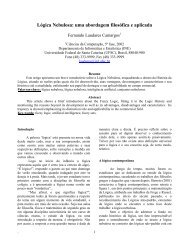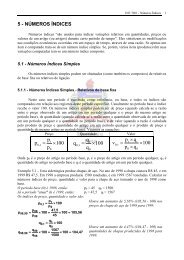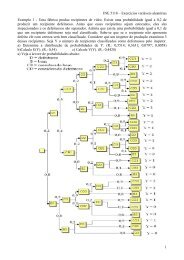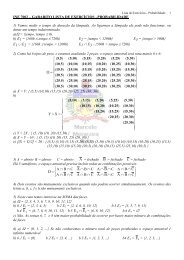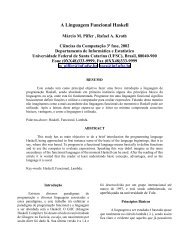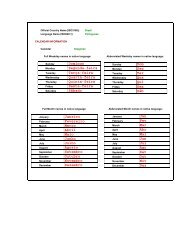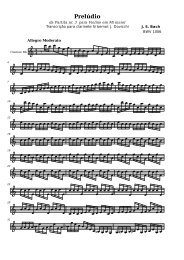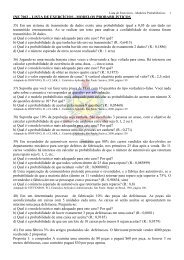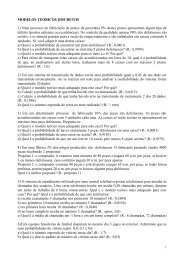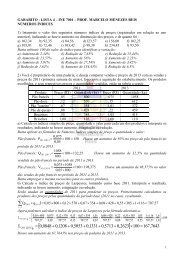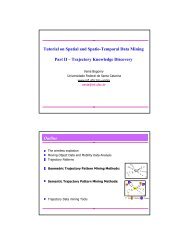Anais do IHC'2001 - Departamento de Informática e Estatística - UFSC
Anais do IHC'2001 - Departamento de Informática e Estatística - UFSC
Anais do IHC'2001 - Departamento de Informática e Estatística - UFSC
Create successful ePaper yourself
Turn your PDF publications into a flip-book with our unique Google optimized e-Paper software.
186<br />
<strong>Anais</strong> <strong>do</strong> IHC’2001 - IV Workshop sobre Fatores Humanos em Sistemas Computacionais<br />
their disposal interfaces which allow them to <strong>de</strong>fine and gradually refine the collections,<br />
portions of collections and services that best suit their needs.<br />
Digital library users typically need to work collaboratively. More often than not, a given<br />
user belongs to more than one regular group of users. It is also possible that library<br />
resources are disjoint for every group a user belongs to, or that some materials need to be<br />
used in several work groups. Thus, for example, a user may participate in a class<br />
discussion for which she is the instructor or facilitator and also in a technical committee<br />
that is reviewing a paper submitted to a conference. For her class, she may suggest a<br />
reading (available at the digital library) which happens to be, say, a missing reference in<br />
the paper being reviewed by the other group in which she participates.<br />
The work <strong>de</strong>scribed in this paper aims to advance along these lines: facilitating the creation<br />
and maintenance of personalized areas (which we call personal spaces) that integrate<br />
resources relevant for a given user, and making it possible for users to seamlessly move<br />
from personal to work group areas and between various group areas (which we call group<br />
spaces).<br />
3. Personal and group spaces.<br />
In the context of a digital library, we <strong>de</strong>fine a personal space as a virtual area that is<br />
generated, owned and maintained by a user to persistently keep resources (objects, agents,<br />
etc.) or references to resources which are relevant to a task or set of tasks the user needs to<br />
perform in the digital library. Personal spaces may thus contain digital <strong>do</strong>cuments in<br />
multiple media, personal schedules, visualization tools, and user agents that have been<br />
<strong>de</strong>legated various tasks. Resources within personal spaces can be pre-assigned according to<br />
the user’s role. For example, a graduate stu<strong>de</strong>nt would have access to course-specific<br />
reserve materials, visualization tools and interfaces to upload thesis chapters for revision by<br />
a committee. Agents may be available for recommending library materials that are relevant<br />
to the thesis and the personal space could be enriched by the agent’s suggestions.<br />
Similarly, we <strong>de</strong>fine a group space as a virtual area in which library users can meet to<br />
conduct collaborative activities synchronously or asynchronously. Explicit group spaces are<br />
created dynamically by a group lea<strong>de</strong>r or facilitator who becomes the owner of the space<br />
and <strong>de</strong>fines who the participants will be. Implicit group spaces can be generated<br />
automatically when a number of users have been <strong>de</strong>tected to have similar user profiles or<br />
interests around a given topic or task. In addition to direct user-to-user communication,<br />
users should be able to access library materials and make annotations on them for every<br />
other group participant to see.<br />
I<strong>de</strong>ally, users should be able to move seamlessly (and carry digital library materials with<br />
them) between personal and group spaces or among group spaces to which they belong.<br />
Figure 1 illustrates a system with four users (each with one personal space, P1-P4) and two<br />
group spaces (G1, G2). Each personal space inclu<strong>de</strong>s a number of library resources (Ri’s),<br />
some also inclu<strong>de</strong>d as part of one or more group spaces. For example, resources R4, R5<br />
and R8 in personal space P2 have been carried to group space G1 to be shared with the<br />
user who owns P1. Moreover, resource R8 is also being shared through group space G2<br />
with the users who own personal spaces P3 and P4. It can be noted also that all resources<br />
in personal space P4 (R12 and R13) are being shared with all other users via group space<br />
G2.



